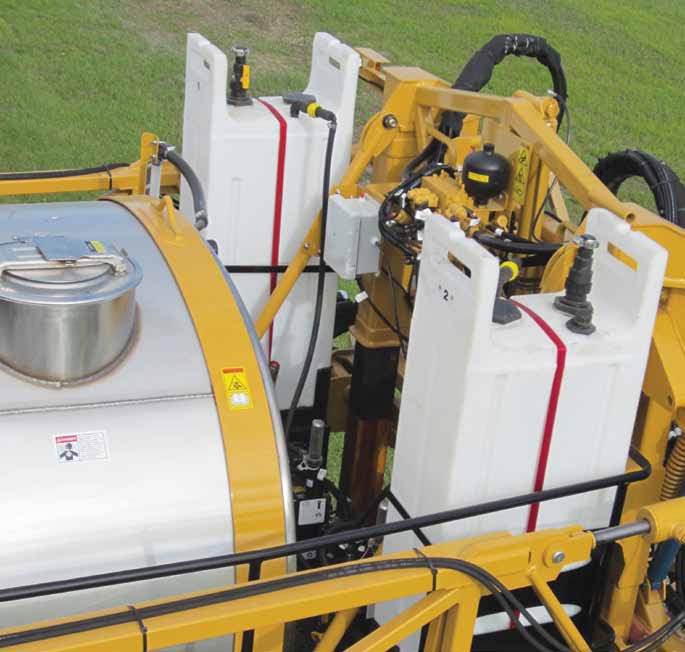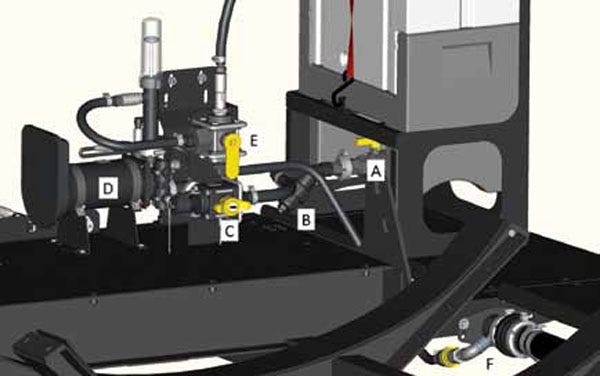December 24, 2013

Chemicals used for spraying weeds have long been mixed in a tank. The problem is, every time you switch products, you have to stop and rinse the tank. This takes time, puts extra product on the ground and exposes the operator to the chemical.
But recently, a technology called direct chemical injection has become more widely accepted, giving operators a viable alternative to the traditional tankmix standby.
Like what you’re reading? Subscribe to Farm Industry News Now e-newsletter to get the latest news and more straight to your inbox twice weekly.
“We’ve seen more injection machines coming out of our factory in the last three years than we have in the last eight years combined,” says Craig Miller, sales and marketing specialist with AGCO’s application equipment division.
Other sprayer manufacturers report the same trend.
Skip the rinse
With direct injection systems, chemical is directly injected into the sprayer line and mixed with a carrier, typically water, right before it is sprayed through the nozzles. This bypasses the need to have one big mix tank that has to be cleaned. The only part that has to be cleaned is the plumbing on the spray boom.
This sprayer technology isn’t new. It has been around since the 1980s. Ag Chem, now owned by AGCO, was one of the first to offer it on its TerraGator and RoGator sprayers under the brand name Talon. AGCO’s Miller says early systems were complex to run and cumbersome to calibrate, which limited use of the products.
New and improved
In 2004, Ag Chem switched to injection pumps called Sidekick made by Raven Industries, and in 2011, upgraded to Raven’s Sidekick Pro. John Deere and Hagie also use Raven’s system. Miller says the newest iteration is much simpler to use, and calibration can be done remotely on a closed-loop system, eliminating the need for manual calibration catch tests. Chemicals can be variably applied at different rates from an in-cab control console.
These advancements in the technology, paired with the growing need for multiple chemicals to control glyphosate- resistant weeds, have driven the resurgence in sales of direct injection sprayers.
Injection basics
Other companies offer comparable systems under different brand names. TeeJet, for example, has offered direct chemical injection systems for years under the TASC, Legacy and now Aeros product names.
All of the systems share the same basic function, which is to inject concentrated
chemicals and water into an in-line mixer on the sprayer. The same system used to apply chemicals also can be used to apply a nitrogen stabilizer with anhydrous ammonia. Typical components include product tanks, pumps, an in-line mixer and electronic shutoff valves. Rates are controlled from an in-cab console.
Benefits of injection
University of Illinois Extension says sprayers equipped with these systems offer some advantages over conventional sprayers.
You can quickly change from one chemical product to another without which is used for water only. The only thing that has to be cleaned is the plumbing on the spray boom.
Operator exposure is reduced. There are no leftover “mixed” chemicals at the end of the field to dispose of. Unused concentrated chemical remains safe and secure in a dedicated holding tank.
And chemical application rates can be adjusted by varying the concentration of chemical injected into the carrier.
Duane Friend, an Extension educator with the University of Illinois, says the decision to upgrade should be based on economics, potential time savings and what is environmentally sound.
Direct injection systems can be ordered as an option on new sprayers or purchased as an after-market kit. A typical two-pump injection system can cost anywhere from $15,500 to $17,000, dealer list price, depending on the required components.
Manufacturers say the cost can be recouped in a few years from chemical savings that result from more accurate dosing.
How direct injection system works
Raven makes a two-tank, two-pump direct injection system called Sidekick Pro, featured on AGCO ’s RoGator sprayers, among others. Chemicals are stored in separate tanks, each with its own pump.
Here’s how the chemicals are dispensed:
Chemicals from each of the tanks go through the tank valve (A), strainer (B) and suction valve (C). This valve  can be used to pull product from the chemical tank or clean water from the fresh water tank. The chemical pump (D) doses the prescribed amount of chemical and sends it through the pressure valve (E), where chemical
can be used to pull product from the chemical tank or clean water from the fresh water tank. The chemical pump (D) doses the prescribed amount of chemical and sends it through the pressure valve (E), where chemical
or fresh water can be recirculated back to the tank or injected (F) into the carrier solution. The carrier solution, typically water, is held in the main stainless-steel tank. From the injection point, the prescribed amounts of water and chemicals are carried through the mix chamber (not shown) and out to the boom before being sprayed out the sprayer.
About the Author(s)
You May Also Like




